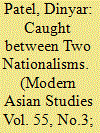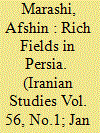|
|
|
Sort Order |
|
|
|
Items / Page
|
|
|
|
|
|
|
| Srl | Item |
| 1 |
ID:
179908


|
|
|
|
|
| Summary/Abstract |
In 1922, a group of wealthy Parsis in Bombay founded an organization that they dubbed the Iran League. Originally designed to assist their fellow Zoroastrians in Iran, who had suffered from centuries of oppression, the League quickly expanded its objectives to include the promotion of broader Indo-Iranian cultural and economic relations. It became a major player in the flow of ideas, literature, business, and tourist traffic between the two countries. Parsi fervour for Iran stemmed from the brand of Iranian nationalism promoted by Reza Shah, which celebrated the country's Zoroastrian past. In response, the League's leaders argued that the Parsis of India could play a special role in the ‘regeneration’ of Iran under the shah's supposedly benign rule. By the 1930s, however, Parsis’ embrace of Iranian nationalism became a clear reflection of their deep concerns about Indian nationalist politics: they cast Iran as an idealized alternative to contemporary India, where the Indian National Congress had supposedly taken an ominously ‘anti-Parsi’ turn. The Iran League, therefore, was caught between two nationalisms. Worry about India's future even prompted some Parsis to argue that their community should ‘return’ to their ancestral homeland of Iran. The story of the Iran League thus demonstrates the complex position of minorities vis-à-vis the brands of nationalism in development during the interwar years. The Parsis, a wealthy but microscopic minority, responded to political anxieties at home by romanticizing a foreign country and taking part in a wholly foreign nationalist project.
|
|
|
|
|
|
|
|
|
|
|
|
|
|
|
|
| 2 |
ID:
189068


|
|
|
|
|
| Summary/Abstract |
This article investigates the history of economic relations between Iran and the Parsi community of India during the Reza Shah period. Encouraged by the policies of the new Pahlavi state, Parsi entrepreneurs began a serious effort to investigate the possibilities of economic investment in Iran. The article details three Parsi economic missions that were conducted in Iran during this period, and analyzes their assessments of Iran's potential for development in fields such as energy, textile manufacturing, commercial agriculture, and modern transportation systems. As the article argues, while these Parsi-led initiatives were part of a larger history of renewed engagement between Parsis and Iranians, for a variety of political and economic reasons, by the outbreak of World War II few of the Parsi plans for investment in Iran had come to fruition. While remaining largely forestalled in the interwar period, the article also suggests that Parsi economic assessments foreshadowed many of the planning strategies carried out in Iran's post–World War II history of economic development.
|
|
|
|
|
|
|
|
|
|
|
|
|
|
|
|
|
|
|
|
|